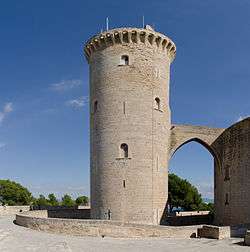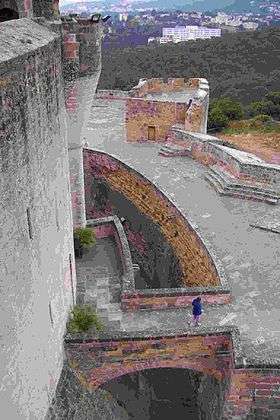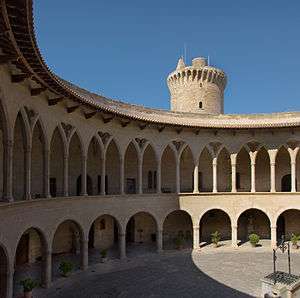Bellver Castle
| Bellver Castle | |
|---|---|
|
Aerial view of the castle | |
| Location | Palma de Mallorca, Spain |
| Coordinates | 39°33′50″N 2°37′10″E / 39.56375°N 2.619338°ECoordinates: 39°33′50″N 2°37′10″E / 39.56375°N 2.619338°E |
| Height | 112 m |
| Built | 1311 |
| Official name: Castillo de Bellver | |
| Type | Non-movable |
| Criteria | Monument |
| Designated | June 3, 1931 |
| Reference no. | RI-51-0000411 |
Bellver Castle[1] (Catalan: Castell de Bellver) is a Gothic style castle on a hill 3 km to the west of the center of Palma on the Island of Majorca, Balearic Islands, Spain. It was built in the 14th century for King James II of Majorca, and is one of the few circular castles in Europe.[2] First serving as the residence of the Kings of Majorca, and afterward long used as a military prison throughout the 18th to mid-20th century, it is now under civilian control, being one of the main tourist attractions of the island, as well as the seat for the city's History Museum.[3]
Origins and Evolution

The castle's plan, circular floor with round towers attached to it seems to have been inspired by the upper complex of the Herodion in the West Bank, which is also circular and has a large principal tower and three minor towers as well. They are attached while the principal one is coupled to the complex by a high bridge over the surrounding moat.
The main part of the fortification was built by architect Pere Salvà, who also worked in the construction of the Royal Palace of La Almudaina, together with other master masons between 1300 and 1311 for King James II of Aragon and Majorca. Rock from the hill where the castle sits was used for the building, which has eventually led to the appearance of cracks. Once the castle had been built, and following the introduction of artillery, the battlements on the top balconies and the barbican disappeared, being soon followed by those in every tower; loopholes were built instead.
History

The castle originally served as a residence for the Kings of Mallorca whenever they were not staying in mainland Europe, and was subsequently seldom used as a residence for viceroys during the 17th century. As a fortification, it suffered and successfully resisted two sieges during the Middle Ages; the first of them in 1343, during Peter IV of Aragon's campaign to reincorporate the Majorcan territories to the Crown of Aragon, and then again in 1391 during an anti-semitic peasant revolt. The castle has only fallen once in its history into enemy hands, in 1521 after an assault during the Majorcan seconds Revolt of the Brotherhoods.
The castle was usually governed by a Lord Warden. In 1408, King Martin I of Aragon gave the lordship of Bellver to the Charterhouse of Jesus of Nazareth in Valldemossa. Charles of Viana arrived in 1459 to take possession of both the island and the castle, as he had agreed with his father King John II of Aragon, even though finally the king did not grant the lordship or Bellver Castle.
Being an enclosed site, since the end of the 14th century it was used as a prison, firstly to hold queen Violant of Mallorca, her children James and Isabella and other supporters of King James III of Mallorca after his death in the Battle of Llucmajor in 1349. During the War of Spanish Succession it was used to imprison first supporters of Phillippe d'Anjou, and after the Bourbon victory, Maulets (supporters of the Habsburg pretender). During the Spanish Independence War it was used to hold several prisoners captured at the battle of Bailén and later, political prisoners, the most famous of these being the minister Gaspar Melchor de Jovellanos (1802–1808) who first made a description of the castle and commissioned the first blueprints and drawings of it. The castle served from then on as a political prison, used to lock up several important supporters of the subsequent Habsburg pretendants to the Spanish Throne during the 19th century, and later notable republican and Catalanist leaders during the 20th century, including Alexandre Jaume, Member of the Parliament who first won the castle for the city, and Emili Darder, who was the mayor of the city, both subsequently shot.

Features
Having been founded as a seat for the royal court of James the raker of Mallorca, its structure combines the needs of a palace with defensive elements. The most notable feature in its structure is its circular shape, unique in Spain. Both its surrounding wall and the inner yard are so-shaped, and so are the three minor towers and the donjon. A moat is found surrounding the castle and its donjon.
The circular inner yard must be highlighted. It has a well in the middle of it, which indicates there is a cistern underneath. The palace itself is structured as a two-story building around the central yard. All its dependencies face this yard through a gallery of gothic semi-circular arches.
Current uses
In 1931, the Spanish Second Republic gave the castle to the city of Palma, along with the forest surrounding it. It became a museum in 1932, being restored in 1976 to become the city's History museum. Thanks to the parking lot and road built next to the castle, it currently welcomes a great number of visitors. The main yard is the seat to many different public ceremonies, such as protocollary and cultural acts, and concerts. Due to its location and visibility from the sea or any other point of the city, it has become one the city's symbols.
The surrounding forest encloses the stables of the city's Mounted Peelers. There is also a chapel dedicated to Saint Alphonsis Rodriguez, built between 1879 and 1885.
The Sunday following Easter Sunday, the citizens gather at the forest and the castle for the celebration of the Diumenge de l'Àngel.
References
- ↑ Bellver Castle, Spain Archived September 2, 2007, at the Wayback Machine.
- ↑ http://www.mallorcawebsite.com/balearik/bellver.html
- ↑ Bellver castle, NorthSouthGuides Bellver Castle, Mallorca
External links
| Wikimedia Commons has media related to Bellver Castle. |
- Virtual 3D-tour of del Castillo de Bellver
- Imágenes del Castillo de Bellver
- Castillo de Bellver en la página del Ayuntamiento de Palma de Mallorca
- Artículo en MallorcaWeb (en mallorquín)
- Vista aérea del castillo en la página web del Ayuntamiento de Palma
- Vista del Castillo de Bellver en Google Maps
- Castillo de Bellver en castillosnet.org

